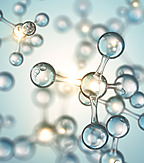article / 01 Nov 2016
Food and life science make a perfect couple

It’s hard to make predictions, especially about the future. This is a classic quote, and we humans are often best at being wise after the event. As the CEO of Livsmedelsakademin – a cluster for food, drink and innovation – I mainly work with the future. That’s why I’m going to take you on a trip through time on the theme of food and Life Science.
Today, innovation is the word on everybody’s lips. Despite this, we’re not seeing any major radical changes and developments in the food industry, which it is in dire need of.
There are many explanations for this. One is that food is a system – from the farmer and the crop to retail and the consumer. A thorough renewal process requires innovation at all stages, making it suddenly complex and hard to comprehend. Consider how many hands and stages a packaged tomato, for example, needs to pass through on its way to your table. Another explanation is naturally that, when it comes to food, we’re highly opposed to taking risks. Getting served a meal to be told only afterwards that you’ve eaten something new and untested – something whose effects are relatively unknown. The displeasure and even disgust that such new, sometimes strange foods evoke is huge and universal. The same can be said for food from an origin that feels foreign.
Food or medicine?
Few people are willing to try a food that gives side effects, in any case in the short term. This is also one of the cornerstones that distinguishes food from medicine. We need both to live, but for entirely different reasons. The latter gives effects – side effects – in the short term, while the former – food – gives side effects in the long term. These side effects are at least known and established, which is why we’re prepared to accept them. We have to eat after all, and the connection is, if not unclear, too long-term for us to start worrying in time in any case. I’m thinking for example of food and diabetes, along with the link now established between cancer and excessive meat consumption. The effects are not instantaneous but rather can be seen in the long term, which makes us less likely to make changes. Everyone who has ever been on a diet also knows how incredibly difficult it is to change dietary habits over time. I am therefore convinced that a new area will emerge between food and medicine, forming the new life science. Let’s call it Life Science 2.0.
Life Science 2.0 will be driven by several different factors. One is digitisation. Think about how many apps you use in the course of a day. Most of us have used one or more even before we’ve got out of bed in the morning. Also, think about how many apps or wearables you now use to check or improve your health. With new technology, many of us now keep tabs on our sleep, the number of steps we take, our heart rhythm and our pulse. Young people see it as a natural part of life.
So let’s go a step further. Today, the links between what we eat and how this affects our health are becoming increasingly clear in research. Unfortunately this research is not translated into new, healthy lifestyle concepts to any great extent. The scope for marketing is too narrow and the path to a commercial product too long and uncertain (no, I’m no fan of EFSA and the “non-development” this authority has created). But what will happen when, in the near future, we immediately see the effects of what we eat? This isn’t science fiction – it’s life science. We will be able to get an instant answer to the question of what a meal or a product does to us. What happens with our blood pressure, blood sugar and cognition?
The technology already exists. There will soon be several simple sensors that can measure this. Bracelets, lenses and other wearables that we can have with us round the clock. Just as natural as measuring our sleep and the number of steps we take is today. Being able to answer the questions this evokes will form a large part of Life Science 2.0. Why is my body reacting like this or that? A colossal challenge for the food industry, but also an opportunity. Here, the industry can enter into close dialogue with the consumer, helping and supporting them in making the right choices. It also provides an opportunity for new and improved products. Food that we can’t even imagine today. Products linked to exercise and movement. Food with special micronutrients that meet individual needs. I-food!
In legal terms, this will present a challenge. Just like in many other areas where digitisation has made an entrance: music, newspapers and magazines, the shared economy, all of which are challenging current legislative and regulatory frameworks. Here, the old distinction between food and medicine will become obsolete, or at least called into question.
But let us think positively about this new area and take to heart the wise words of Hippocrates “Let food be thy medicine and medicine be thy food.”
Lotta Törner
CEO, Livsmedelsakademin
Contact:
Practice areas:

